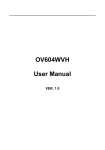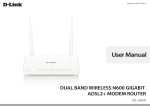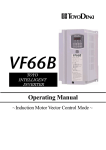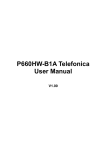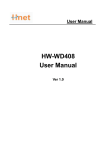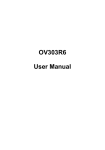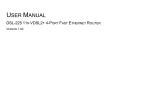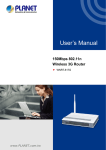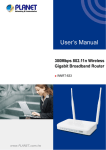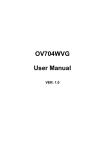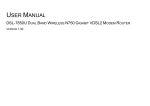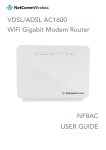Download 802.11n Dual band Wireless VDSL 2 Router
Transcript
User Manual of VDR-300NU 1 Copyright Copyright 2014 by PLANET Technology Corp. All rights reserved. No part of this publication may be reproduced, transmitted, transcribed, stored in a retrieval system, or translated into any language or computer language, in any form or by any means, electronic, mechanical, magnetic, optical, chemical, manual or otherwise, without the prior written permission of PLANET. PLANET makes no representations or warranties, either expressed or implied, with respect to the contents hereof and specifically disclaims any warranties, merchantability or fitness for any particular purpose. Any software described in this manual is sold or licensed "as is". Should the programs prove defective following their purchase, the buyer (and not this company, its distributor, or its dealer) assumes the entire cost of all necessary servicing, repair, and any incidental or consequential damages resulting from any defect in the software. Further, this company reserves the right to revise this publication and to make changes from time to time in the contents hereof without obligation to notify any person of such revision or changes. All brand and product names mentioned in this manual are trademarks and/or registered trademarks of their respective holders. Federal Communication Commission Interference Statement This equipment has been tested and found to comply with the limits for a Class B digital device, pursuant to Part 15 of FCC Rules. These limits are designed to provide reasonable protection against harmful interference in a residential installation. This equipment generates, uses, and can radiate radio frequency energy and, if not installed and used in accordance with the instructions, may cause harmful interference to radio communications. However, there is no guarantee that interference will not occur in a particular installation. If this equipment does cause harmful interference to radio or television reception, which can be determined by turning the equipment off and on, the user is encouraged to try to correct the interference by one or more of the following measures: 1. Reorient or relocate the receiving antenna. 2. Increase the separation between the equipment and receiver. 3. Plug the equipment into an outlet on a circuit different from that to which the receiver is connected. 4. Consult the dealer or an experienced radio technician for help. FCC Caution: To assure continued compliance, (example-use only shielded interface cables when connecting to computer or peripheral devices) any changes or modifications not expressly approved by the party responsible for compliance could void the user’s authority to operate the equipment. 2 This device complies with Part 15 of the FCC Rules. Operation is subject to the Following two conditions: (1) This device may not cause harmful interference (2) This Device must accept any interference received, including interference that may cause undesired operation. Federal Communication Commission (FCC) Radiation Exposure Statement This equipment complies with FCC radiation exposure set forth for an uncontrolled environment. In order to avoid the possibility of exceeding the FCC radio frequency exposure limits, human proximity to the antenna shall not be less than 20 cm (8 inches) during normal operation. R&TTE Compliance Statement This equipment complies with all the requirements of DIRECTIVE 1999/5/CE OF THE EUROPEAN PARLIAMENT AND THE COUNCIL OF 9 March 1999 on radio equipment and telecommunication terminal Equipment and the mutual recognition of their conformity (R&TTE). The R&TTE Directive repeals and replaces in the directive 98/13/EEC (Telecommunications Terminal Equipment and Satellite Earth Station Equipment) As of April 8, 2000. Safety This equipment is designed with the utmost care for the safety of those who install and use it. However, special attention must be paid to the dangers of electric shock and static electricity when working with electrical equipment. All guidelines of this and of the computer manufacture must therefore be allowed at all times to ensure the safe use of the equipment. National Restrictions This device is intended for home and office use in all EU countries (and other countries following the EU directive 1999/5/EC) without any limitation except for the countries mentioned below: Country Restriction Bulgaria None Reason/remark General authorization required for outdoor use and public service Military Radiolocation use. Refarming of the 2.4 Outdoor use limited to France GHz band has been ongoing in recent years to allow 10 mW e.i.r.p. within the current relaxed regulation. Full implementation band 2454-2483.5 MHz Italy None Luxembourg None planned 2012 If used outside of own premises, general authorization is required General authorization required for network and service supply(not for spectrum) This subsection does not apply for the geographical Norway Implemented area within a radius of 20 km from the centre of Ny-Ålesund 3 Russian None Only for indoor applications Federation WEEE regulation To avoid the potential effects on the environment and human health as a result of the presence of hazardous substances in electrical and electronic equipment, end users of electrical and electronic equipment should understand the meaning of the crossed-out wheeled bin symbol. Do not dispose of WEEE as unsorted municipal waste; WEEE should be collected separately. Revision User’s Manual for 802.11n Dual band Wireless VDSL2 Router Model: VDR-300NU Rev: 1.0 (January, 2014) Part No. EM-VDR-300NU_v1 (2081-AC0360-000) 4 User Manual of VDR-300NU Table of Contents CHAPTER 1.PRODUCT INTRODUCTION .........................................................................8 1.1 Package Contents .............................................................................................................. 8 1.2 Product Description ........................................................................................................... 9 1.3 Product Features .............................................................................................................. 12 1.4 Product Specifications..................................................................................................... 14 CHAPTER 2. HARDWARE INSTALLATION ....................................................................18 2.1 Hardware Description ...................................................................................................... 18 2.1.1 Front Panel............................................................................................................................... 18 2.1.2 LED Indications ........................................................................................................................ 18 2.1.3 Rear Panel and Side Panel...................................................................................................... 20 2.1.4 Right Side Panel ...................................................................................................................... 21 CHAPTER 3. CONNECTING TO THE ROUTER ..............................................................22 3.1 System Requirements...................................................................................................... 22 3.2 Installing the Router......................................................................................................... 22 CHAPTER 4. INSTALLATION GUIDE ..............................................................................25 4.1 Configuring PC in Windows 7 ......................................................................................... 25 4.2 Configuring PC in Windows XP ...................................................................................... 27 CHAPTER 5. SYSTEM SETTINGS...................................................................................29 5.1 Device Information ........................................................................................................... 30 5.1.1 Summary .................................................................................................................................. 30 5.1.2 WAN ......................................................................................................................................... 31 5.1.3 Statistics ................................................................................................................................... 31 5.1.4 Route........................................................................................................................................ 34 5.1.5 ARP .......................................................................................................................................... 35 5.1.6 DHCP ....................................................................................................................................... 35 5.2 Advanced Setup ............................................................................................................... 36 5.2.1 Layer2 Interface ....................................................................................................................... 36 5.2.2 WAN Service............................................................................................................................ 40 5.2.3 3G WAN Service ...................................................................................................................... 57 5.2.4 LAN Configuration.................................................................................................................... 60 5 5.2.5 NAT .......................................................................................................................................... 63 5.2.6 Security .................................................................................................................................... 66 5.2.7 Parental Control ....................................................................................................................... 69 5.2.8 Quality of Service ..................................................................................................................... 71 5.2.9 Routing ..................................................................................................................................... 74 5.2.10 DNS........................................................................................................................................ 77 5.2.11 DSL ........................................................................................................................................ 78 5.2.12 UPnP ...................................................................................................................................... 79 5.2.13 DNS Proxy ............................................................................................................................. 80 5.2.14 Print Server ............................................................................................................................ 80 5.2.15 DLNA...................................................................................................................................... 82 5.2.16 Packet Acceleration ............................................................................................................... 82 5.2.17 Storage Service...................................................................................................................... 83 5.2.18 Interface Grouping ................................................................................................................. 87 5.2.19 IP Tunnel................................................................................................................................ 88 5.2.20 IPSec...................................................................................................................................... 90 5.2.21 Certificate ............................................................................................................................... 91 5.2.22 Power Management ............................................................................................................... 95 5.2.23 Multicast ................................................................................................................................. 96 5.3 Wireless............................................................................................................................. 97 5.3.1 Basic Settings .......................................................................................................................... 97 5.3.2 Security .................................................................................................................................... 99 5.3.3 MAC Filter .............................................................................................................................. 108 5.3.4 Wireless Bridge ...................................................................................................................... 109 5.3.5 Advanced Settings ................................................................................................................. 110 5.3.6 Station Info ............................................................................................................................. 113 5.4 Diagnostics ..................................................................................................................... 114 5.4.1 Diagnostics............................................................................................................................. 114 5.4.2 Fault Management ................................................................................................................. 114 5.5 Management ................................................................................................................... 116 5.5.1 Settings .................................................................................................................................. 116 5.5.2 System Log ............................................................................................................................ 117 5.5.3 SNMP Agent .......................................................................................................................... 119 5.5.4 TR-69 Client ........................................................................................................................... 120 6 5.5.5 Internet Time .......................................................................................................................... 121 5.5.6 Access Control ....................................................................................................................... 121 5.5.7 Update Software .................................................................................................................... 123 5.5.8 Reboot.................................................................................................................................... 123 APPENDIX A: PLANET DDNS .......................................................................................124 APPENDIX B: PERFORMANCE OF VDSL ROUTER PROFILES .................................126 APPENDIX C: GLOSSARY.............................................................................................127 7 User Manual of VDR-300NU Chapter 1.Product Introduction 1.1 Package Contents Thank you for choosing PLANET VDR-300NU. Before installing the router, please verify the contents inside the package box. VDR-300NU Quick Installation CD-ROM Guide (User Manual included) Power Adapter 12V/2A DC output 100~240V AC input Ethernet Cable Phone Cable RJ-45 / CAT5E 1.5 meter UTP RJ11 telephone wire VDSL Splitter If there is any item missing or damaged, please contact the seller immediately. 8 User Manual of VDR-300NU 1.2 Product Description High Performance Ethernet over VDSL PLANET 802.11n Dual Band Wireless VDSL2 Router, VDR-300NU, applies 2T2R MIMO antenna technology and provides office and residential users with the ideal solution for sharing a high-speed VDSL2 broadband connection and four-10/100Mbps Fast Ethernet backbone. The VDR-300NU is developed with three core networking technologies: IEEE 802.11a/b/g/n, Ethernet and VDSL2 (Very High Speed Digital Subscriber Line 2). Via VDSL 2 technology, the VDR-300NU offers very high performance access to Internet, up to 100Mbps for both downstream and upstream data transmission. VDSL2 absolutely offers the fastest data transmission speed over existing copper telephone lines without the need for rewiring. 300Mbps Upstream ISP Internet 100/100Mbps Downstream 802.11a/b/g/n Wireless Laptop VDR-300NU VDSL2 Telephone Wire 2.4/5GHz 802.11a/b/g/n Delivering High-Demand Service Connectivity for ISP / Triple Play Devices The VDR-300NU provides excellent bandwidth to satisfy the triple play devices for home entertainment and communication. With the capability of 100/100Mbps symmetric data transmission, the VDR-300NU enables many multi-media services to work on local Internet, such as VOD (Video on Demand), Voice over IP, Video phone, IPTV, Internet caching server, distance education, and so on. Dual Band High-Speed 802.11n Wireless The VDR-300NU complies with ITU-T G993.2 standard and provides two modes for network applications -- Bridge and Router. With built-in IEEE 802.11b/g and 802.11a/n wireless network capability, the VDR-300NU allows any computer and wireless-enabled network device to connect to it without additional cabling. 802.11n wireless capability brings users the highest speed of wireless experience ever; the data transmission rate can be as high as 300Mbps. The radio coverage is also doubled to offer high speed wireless connection even in widely spacious offices or houses. 300Mbps 802.11n 802.11g 802.11b 54Mbps 11Mbps *Theory Value 9 6X faster User Manual of VDR-300NU Secure Wireless Access Control To secure wireless communication, the VDR-300NU supports most up-to-date encryptions including WEP, WPA-PSK and WPA2-PSK. Moreover, the VDR-300NU supports WPS configuration with PBC/PIN type for users to easily connect to a secured wireless network. Multiple Functions for Broadband Communication The VDR-300NU integrates wireless LAN, USB storage, and 3G WAN services into one unit. It is designed to provide a simple and cost-effective xDSL Internet connection for a private Ethernet and 802.11a/b/g/n wireless network. The Router combines high-speed xDSL Internet connection, IP routing for the LAN and wireless connectivity in one package. It is usually preferred to provide high access performance applications for the individual users, the SOHOs, and the small enterprises. 10 User Manual of VDR-300NU Providing Superior Function The VDR-300NU provides user-friendly management interface to be managed easily through standard web browsers. For networking management features, the VDR-300NU not only provides basic router functions such as DHCP server, virtual server, DMZ, QoS, and UPnP, but also provides full firewall functions including Network Address Translation (NAT), IP/Port/MAC Filtering and Content Filtering. Furthermore, the VDR-300NU serves as an Internet firewall to protect your network from being accessed by unauthorized users. More Flexible File Sharing over USB port The VDR-300NU is built-in with two USB 2.0 ports which can be connected to a USB printer or storage device for file sharing. It can recognize the USB printer or storage automatically without user experience. Thus, all clients on the network can share printer or mass storage through the VDR-300NU without complicated network configuration. Via the USB port, it also can output 5V DC power to charge any USB compliant devices. 11 User Manual of VDR-300NU 1.3 Product Features Internet Access Features Shared Internet Access: All users on the LAN can access the Internet through the VDR-300NU using only one single external IP address. The local (invalid) IP addresses are hidden from external sources. This process is called NAT (Network Address Translation). Built-in VDSL2 Modem: The VDR-300NU provides VDSL2 modem and supports all common VDSL2 connections. Multiple WAN Connections: Upon the Internet (WAN port) connection, the VDR-300NU supports ADSL2+, VDSL2, and 3G with USB port. Advanced Internet Functions Virtual Servers: This feature allows Internet users to access Internet servers on your LAN. The setup is quick and easy. Firewall: The VDR-300NU supports simple firewall with NAT technology. Universal Plug and Play (UPnP): UPnP allows automatic discovery and configuration of the Broadband Router. UPnP is supported by Windows ME, XP, or later. DMZ Support: The VDR-300NU can translate public IP addresses into private IP address to allow unlimited 2-way communication with the servers or individual users on the Internet. It provides the most flexibility to run programs smoothly for programs that might be restricted in NAT environment. RIP1/2 Routing: It supports RIPv1/2 routing protocol for routing capability. IGMP Snooping: IGMP can be used for one-to-many networking applications such as online streaming video and gaming, and allows more efficient use of resources when supporting these types of applications. LAN Features 4-Port Switch: The VDR-300NU incorporates a 4-port 10/100Base-TX switching hub, making it easy to create or extend your LAN. DHCP Server Support: Dynamic Host Configuration Protocol provides a dynamic IP address to PCs and other devices upon request. The VDR-300NU can act as a DHCP Server for devices on your local LAN. Wireless Features Supports IEEE 802.11a/b/g/n Dual Band Wireless Stations: The VDR-300NU supports the selectable 2.4GHz and 5GHz wireless connection. 802.11n standard provides backward compatibility with the 802.11b and 802.11g standard, so 802.11b, 802.11g, and 802.11n can be used simultaneously. IEEE 802.11n wireless technology is capable of up to 300Mbps data rate. WPS Push Button Control: The VDR-300NU supports WPS (Wi-Fi Protected Setup) for users to easily connect to wireless network without configuring the security. Advanced Security: 64/128-bit WEP, WPA/WPA2 and WPA-PSK/WPA2-PSK(TKIP/AES encryption), 802.1x 12 User Manual of VDR-300NU Wireless MAC Access Control: The Wireless Access Control feature can check the MAC address (hardware address) of wireless stations to ensure that only trusted wireless stations can access your LAN. Dual-SSID: It allows users to access different networks through a single AP. 13 User Manual of VDR-300NU 1.4 Product Specifications Model VDR-300NU Product Description 802.11n Dual Band Wireless VDSL2 Router Hardware Specifications Interfaces LAN 4 x 10/100Base-TX, Auto-Negotiation, Auto MDI/MDI-X RJ45 port WAN 1 x RJ-11 USB USB 2.0, Type-A, 5V DC/0.5A Output Antenna 2.4GHz : 2 x 2.5dBi 5GHz: 2 x 2dBi Button 1 x RESET button 1 x WPS button LED Indicators PWR, DSL, LAN1-4, WLAN, WPS, Security Dimensions (W x D x H) 180 x 145 x 54 mm Weight 306g Power 12V DC, 2A Power Consumption 18W (not including power adapter) Router Features Internet Connection Type Shares data and Internet access for users, supporting the following internet accesses: PPPoE Dynamic IP Static IP ITU-T G.993.2 VDSL2 Supports 8a,8b,12a,12b,17a,30a profile VDSL Features Supports G.vector Supports ATM and PTM Supports G.INP T1.413i2, G.992.1 G.dmt, G.992.2, G.lite G.992.3 (G.bis/ADSL2) G.992.5 (ADSL2+) ITU G.994.1 (G.hs) ADSL Features Annex L (Reach Extended ADSL2) Supports ATM forum UNI3.0, 3.1 and 4.0 permanent virtual circuits (PVCs) Supports CBR, UBR, VBR-rt, VBR-nrt Supports multiple PVCs Supports ITU-T i.610F4/F5 OAM Self-learning bridge (IEEE 802.1D Transparent Bridging) Bridging Features At least 64 learning MAC addresses Supports IGMP snooping 14 User Manual of VDR-300NU RFC2684 multiprotocol Encapsulation over ATM Adaptation Layer 5 RFC1483 multiprotocol Encapsulation over ATM Adaptation Layer 5 RFC2364 PPP over ATM ALL5 (PPPoA) RFC2516 PPP Over Ethernet (PPPoE) RFC1662 PPP in HDLC-like Framing RFC1332 PPP Internet Protocol Control Protocol RFC1577/2225 Classical IP and ARP over ATM (IPoA) RFC894 A Standard for the Transmission of IP Datagrams over Protocol Features Ethernet Networks RFC1042 A standard for the Transmission of IP Datagrams over IEEE 802 Networks MER (a.k.a IP over Ethernet over AAL5) Supports ALG (Application Level Gateways) IEEE802.3 IEEE802.3u IEEE 802.11b IEEE 802.11g IEEE 802.11n RFC768 User Datagram Protocol (UDP) RFC791 Internet Protocol (IP) RFC792 Internet Control Message Protocol (ICMP) RFC793 Transmission Control Protocol (TCP) RFC826 An Ethernet Address Resolution Protocol (ARP) RFC862 Echo Protocol Supports IP routing Routing Features Supports transparent bridging Supports source and destination routing Supports DHCP server/client Supports UPnP Supports NAT,NAPT Supports DMZ Supports IP QoS Supports IGMP proxy Supports IPv6 Three-level login including local admin, local user, and remote technical support access Service access control based on incoming interface: WAN or LAN Security Service access control based on source IP addresses Protects DOS attacks from WAN: SYN flooding, IP surfing, ping of Death, fragile, UDP ECHO (port 7), teardrop, land PAP (RFC1334), CHAP (RFC1994), MSCHAP for PPP session IP filter, parental control 15 User Manual of VDR-300NU Device Configuration, Management and Update Web based GUI Localization support Embedded web server Download image via HTTP, TFTP client, TFTP server, FTP server Management Command Line Interface via serial port, telnet, or ssh Menu-driven CLI via serial port or telnet Universal Plug and Play (UPnP) Internet Gateway Device (IGDv1.0) WAN Management Protocol (TR-069) SNMP v1/v2 PSI configuration file upload and download Date/time update from SNTP Internet Time Server Wireless Interface Specifications Wireless Standard IEEE 802.11a/b/g/n Frequency Band 2.4GHz: 2.412~2.484GHz 5GHz: 5.180~5.825GHz 802.11g: 64QAM, 16QAM, QPSK, BPSK, DSSS Modulation Schemes 802.11b: CCK, DQPSK, DBPSK HT20 and HT40: 64 QAM, 16QAM, QPSK, BPSK 802.11n(40MHz): up to 300 Mbps 802.11n(20MHz): up to 144.4 Mbps Data Transmission Rates 802.11g: 54, 48, 36, 24, 18, 12, 9, 6 Mbps per channel, auto fallback for extended range 802.11b: 1, 5.5, 2, 1 Mbps per channel, auto fallback for extended range 802.11a: 54, 48, 36, 24, 18, 12, 9, 6 Mbps 2.4GHz: 11b: 18±1.5dBm 11g: 14.5±1.5dBm 11n(20M): 16.5±1.5dBm (MCS0~3) 14.5±1.5dBm (MCS4~7) RF Power 16.5±1.5dBm (MCS8~11) 14.5±1.5dBm (MCS12~15) 11n(40M): 14±1.5dBm (MCS0~3) 12.5±1.5dBm (MCS4~7) 14±1.5dBm (MCS8~11) 12.5±1.5dBm (MCS12~15) Wireless Data Encryption 64/128-bit WEP, WPA-PSK, WPA2-PSK, 802.1x encryption, and WPS PBC 16 User Manual of VDR-300NU Environment Specifications Temperature / Humidity Operating: 0~40 degrees C, 10%~ 95% (non-condensing), Storage: -20~70 degrees C, 5~95% (non-condensing) Certification CE 17 User Manual of VDR-300NU Chapter 2. Hardware Installation This chapter offers information about installing your router. If you are not familiar with the hardware or software parameters presented here, please consult your service provider for the values needed. 2.1 Hardware Description 2.1.1 Front Panel The front panel provides a simple interface monitoring of the router. Figure 2-1 shows the front panel of VDR-300NU. Figure 2-1 VDR-300NU Front Panel 2.1.2 LED Indications The LEDs on the top panel indicate the instant status of system power, WAN data activity and port links, and help monitor and troubleshoot when needed. Figure 2-1 and Table 2-1 show the LED indications of the VDR-300NU. 18 User Manual of VDR-300NU Figure 2-2 VDR-300NU LED Front Panel LED Definition LED Color State ON PWR Green Red Green Internet Green Red LAN1-4 WLAN WPS USB Green Green Green Green When the router is powered on, and in ready state. Flashing The software is upgrading. OFF The device is powered off. ON The device is initiating. Flashing ON DSL Description Flashing The software is upgrading. The VDSL2 is connected successfully. Router is trying to establish a VDSL2 connection to VDSL2 device or telecom’s network. OFF The device is powered off. ON Internet is synchronized successfully in the route mode. Flashing Internet data is being transmitted. OFF Ethernet interface is disconnected. ON Authentication has failed. ON The Ethernet interface is connected. Flashing Data is being transmitted or received via the corresponding LAN port. OFF The Ethernet interface is disconnected. ON WLAN is enabled. Flashing Data is being transmitted through the wireless interface. OFF WLAN is disabled. ON Connection succeeds under Wi-Fi Protected Setup. Flashing Negotiation is in progress under Wi-Fi Protected Setup. OFF Wi-Fi Protected Setup is disabled. ON The connection of 3G or USB device has established. Flashing OFF Data is being transmitted. No signal is detected. Table 2-1 The LED indication of VDR-300NU 19 User Manual of VDR-300NU 2.1.3 Rear Panel and Side Panel The rear panel provides the physical connectors connected to the power adapter and any other network device. Figure 2-2 and Figure 2-3 shows the rear and side panel of the VDR-300NU. Figure 2-3 VDR-300NU Rear Panel Rear Panel Port and Button Definition Connector POWER USB2 RESET LAN (1-4) DSL Description Power connector with 12V DC, 2 A For connecting the 3G network adapter or other USB storage devices. Press more than 2 seconds for resetting to factory default setting. Router is successfully connected to a device through the corresponding port (1, 2, 3, or 4). If the LED light of LNK/ACT is flashing, the Router is actively sending or receiving data over that port. The RJ-11 connector allows data communication between the router and the DSL network through a twisted-pair phone wire 20 User Manual of VDR-300NU 2.1.4 Right Side Panel WPS USB Figure 2-4 VDR-300NU Side Panel Side Panel Interface and Button Definition Connector Description On/Off Power switch. USB1 For connecting the 3G network adapter or other USB storage devices. WLAN WLAN switch, for enabling or disabling the WLAN function. WPS This button is used for enabling WPS PBC mode. If WPS is enabled, press this button, and then the wireless router starts to accept the negotiation of PBC mode. 21 User Manual of VDR-300NU Chapter 3. Connecting to the Router 3.1 System Requirements Broadband Internet Access Service (Cable/xDSL/Ethernet connection) One Cable/xDSL Modem that has an RJ-45 connector (not necessary if the Router is connected directly to the Ethernet.) PCs with a working Ethernet Adapter and an Ethernet cable with RJ-45 connectors PCs running Windows 98/ME, NT4.0, 2000/XP, Windows Vista / Win 7, MAC OS 9 or later, Linux, UNIX or other platforms are compatible with TCP/IP protocols The above PCs are installed with Web browser 1. The Router in the following instructions is named as PLANET VDR-300NU. 2. It is recommended to use Internet Explorer 8.0 or above to access the Router. 3.2 Installing the Router Please connect the device to you computer as follows: STEP 1. Connect the DSL port of the router and the Modem port of the splitter with a telephone cable; connect the phone to the phone port of the splitter through a cable; and connect the incoming line to the Line port of the splitter. The spliiter has three ports: Line: Connect to a wall phone jack (RJ-11 jack) Modem: Connect to the Line interface of the router Phone: Connect to a telephone set 22 User Manual of VDR-300NU STEP 2. Connect the Power Adapter to the VDR-300NU. Check whether the PWR LED on the front panel are on accordingly. Figure3-1 shows the power adapter connection diagram. Figure 3-1: VDR-300NU Power Adapter Connection Diagram STEP 3. Use Ethernet cable to connect “LAN” port of the router and “LAN” port of your computer. Follow Figure 3-2 to connect the network devices. Figure 3-2: VDR-300NU Connection Diagram 23 User Manual of VDR-300NU If you use 3G WAN service, connect the 3G USB data card to the USB port of the router. 24 User Manual of VDR-300NU Chapter 4. Installation Guide 4.1 Configuring PC in Windows 7 1. Go to Start / Control Panel / Network and Internet / Network and Sharing Center and click Change adapter settings on the left banner. 2. Double-click Local Area Connection. 3. In the Local Area Connection Status window, click Properties. 4. Select Internet Protocol Version 4 (TCP/IPv4) and click Properties. 25 User Manual of VDR-300NU 5. Select the Obtain an IP address automatically and the Obtain DNS server address automatically button. 6. Click OK to finish the configuration. 26 User Manual of VDR-300NU 4.2 Configuring PC in Windows XP 1. Go to Start / Control Panel (in Classic View). In the Control Panel, double-click on Network Connections 2. Double-click Local Area Connection. 3. In the Local Area Connection Status window, click Properties. 4. Select Internet Protocol (TCP/IP) and click Properties. 27 User Manual of VDR-300NU 5. Select the Obtain an IP address automatically and the Obtain DNS server address automatically button. 6. Click OK to finish the configuration. 28 User Manual of VDR-300NU Chapter 5. System Settings Determine your Connection Settings Before you configure the router, you need to know the connection information supplied by your Internet service provider. Connecting the VDSL 2 Router to your Network Unlike a simple hub or switch, the setup of the VDSL Router consists of more than simply plugging everything together. Because the Router acts as a DHCP server, you will have to set some values within the Router, and also configure your networked PCs to accept the IP Addresses the Router chooses to assign them. Generally there are several different operating modes for your applications. And you can know which mode is necessary for your system from ISP. These modes are router, bridge, and PPPoE+NAT. Configuring with Web Browser It is advisable to change the administrator password to safeguard the security of your network. To configure the router, open your browser, type “http: //192.168.1.1” into the address bar and click “Go” to get to the login page. Save this address in your Favorites for future reference. At the User Name prompt, type “admin”, and the Password prompt, type “admin”. You can change these later if you wish. Click “OK” to login the router and you can start to configure it now. 29 User Manual of VDR-300NU 5.1 Device Information Choose Device Info, and the submenus of Device Info are shown below: Figure 5-1-1 5.1.1 Summary Choose Device Info > Summary, and the following page appears. Figure 5-1-2 This page displays the device information such as the board ID, software version, and the information of your WAN connection such as the upstream rate and the LAN address. 30 User Manual of VDR-300NU 5.1.2 WAN Choose Device Info > WAN and the following page appears. Figure 5-1-3 This page displays the information of the WAN interface. You can select from Advanced Setup > Layer2 Interface to choose the type you need. 5.1.3 Statistics Choose Device Info > Statistics, and the following page appears. LAN Choose Device Info > Statistics > LAN and the following page appears. Figure 5-1-4 On this page, you can view the statistical information about the received and transmitted data packets of the Ethernet and wireless interfaces. Click Reset Statistics to restore the values to zero and recount them. WAN Service Choose Device Info > Statistics > WAN Service and the following page appears. 31 User Manual of VDR-300NU Figure 5-1-5 On this page, you can view the statistical information about the received and transmitted data packets of the WAN interface. Click Reset Statistics to restore the values to zero and recount them. xTM Choose Device Info > Statistics > xTM and the following page appears. Figure 5-1-6 On this page, you can view the statistical information about the received and transmitted data packets at the xTM interfaces. Click the Reset button to restore the values to zero and recount them. xDSL Choose Device Info > Statistics > xDSL and the following page appears. 32 User Manual of VDR-300NU Figure 5-1-7 On this page, you can view the statistical information about the received and transmitted data packets of the xDSL interfaces. xDSL BER Test Click xDSL BER Test to perform a bit error rate (BER) test on the DSL line. The test page is as follows: Figure 5-1-8 The Tested Time (sec) can be 1, 5, 10, 20, 60, 120, 180, 240, 300, or 360. Select a time in the drop-down list and click Start. The following pages appear. 33 User Manual of VDR-300NU Figure 5-1-9 When the xDSL BER Test completes, the following page appears. Figure 5-1-10 If the BER reaches e-5, you cannot access the Internet. 5.1.4 Route Choose Device Info > Route and the following page appears. On this page, you can view the route table information. Figure 5-1-11 34 User Manual of VDR-300NU 5.1.5 ARP Choose Device Info > ARP and the following page appears. Figure 5-1-12 On this page, you can view the MAC address and IP address information of the device connected to the router. 5.1.6 DHCP Choose Device Info > DHCP and the following page appears. Figure 5-1-13 On this page, you can view the host name, the IP address assigned by the DHCP server, the MAC address corresponding to the IP address, and the DHCP lease time. 35 User Manual of VDR-300NU 5.2 Advanced Setup Choose Advanced Setup and the submenus of Advanced Setup are shown below: Figure 5-2-1 5.2.1 Layer2 Interface Choose Advanced Setup > Layer2 Interface and the following page appears. ATM Interface Choose Advanced Setup > Layer2 Interface > ATM Interface . On this page, you can add or remove to configure DSL ATM Interfaces. Figure 5-2-2 Click Add to add ATM Interface and the following page appears. 36 User Manual of VDR-300NU Figure 5-2-3 On this page, you can enter this PVC (VPI and VCI) value, and select DSL link type (EoA is for PPPoE, IPoE, and Bridge.), encapsulation mode and service category. Object Description VPI (Virtual Path Identifier) The virtual path between two points in an ATM network, and its valid VCI (Virtual Channel Identifier) The virtual channel between two points in an ATM network, ranging DSL Link Type EoA (It is for PPPoE, IPoE, and Bridge), PPPoA, or IPoA Encapsulation Mode LLC/SNAP-BRIDGING, or VC/MUX Service Category Select Scheduler for Queues of Equal Precedence as the Default Queue value is from 0 to 255. from 32 to 65535 (1 to 31 are reserved for known protocols). UBR Without PCR, UBR With PCR, CBR, Non Realtime VBR, Realtime VBR. Weighted Round Robin or Weighted Fair Queuing. Click Apply/Save to save the configuration. 37 User Manual of VDR-300NU If you want to remove this Interface, please select the Remove check box and click Remove. PTM Interface Choose Advanced Setup > Layer2 Interface > PTM Interface, and the following page appears. On this page, you can add or remove to configure PTM WAN Interfaces. Figure 5-2-4 Click Add and the following page appears. Figure 5-2-5 On this page, you can select scheduler for queues of equal precedence and enter the queue value. Click Apply/Save to save configuration. ETH Interface Choose Advanced Setup > Layer2 Interface > ETH Interface and the following page appears. On this page, you can add or remove to configure ETH WAN Interfaces. 38 User Manual of VDR-300NU Figure 5-2-6 Click Add and the following page appears. Figure 5-2-7 On this page, you can select an ETH port. Click Apply/Save to save configuration. If ETH Interface is selected, there are two WAN service types (PPPoE and IPoE). 39 User Manual of VDR-300NU 5.2.2 WAN Service Choose Advanced Setup > WAN Service and the following page appears. Figure 5-2-8 On this page, you are allowed to add, remove, or edit a WAN service. If PTM Interface is selected, there are three WAN service types: PPP over Ethernet (PPPoE), IP over Ethernet, and Bridging. And the corresponding configurations of PTM WAN service are the same as the configurations of ATM WAN service. Adding a PPPoE WAN Service This section describes the steps for adding the PPPoE WAN service. Step1 First, add a proper ATM or PTM interface for this WAN service at Layer2 Interface. Figure 5-2-9 Figure 5-2-10 40 User Manual of VDR-300NU Step2 On the WAN Service page, click the Add button to display as Figure 5-2-11 shows. You can select ATM or PTM Interface for the WAN service and then click Next. Figure 5-2-11 Step3 On this page, select the WAN service type to be PPP over Ethernet (PPPoE). Click Next to continue the setting. Figure 5-2-12 Step4 In this page, you can modify the PPP username, PPP password, PPPoE service name and authentication method. 41 User Manual of VDR-300NU Figure 5-2-13 Object PPP Username PPP Password PPPoE Service Name Authentication Method Description The correct user name provided by your ISP. The correct password provided by your ISP. If your ISP provides it to you, please enter it. If not, do not enter any information. The value can be AUTO, PAP, CHAP, or MSCHAP. Usually, you can select AUTO. NAT is one where all requests from the same internal IP address Enable Fullcone NAT and port are mapped to the same external IP address and port. Furthermore, any external host can send a packet to the internal host, by sending a packet to the mapped external address. Dial on demand (with idle timeout timer) If this function is enabled, you need to enter the idle timeout time. Within the preset minutes, if the modem does not detect the flow of the user continuously, the modem automatically stops the PPPoE 42 User Manual of VDR-300NU connection. Once it detects the flow (like access to a webpage), the modem restarts the PPPoE dialup. If this function is disabled, the modem performs PPPoE dial-up all the time. The PPPoE connection does not stop, unless the modem is powered off and DSLAM or uplink equipment is abnormal. PPP IP extension If you want to configure DMZ Host, you should enable it first. If this function is disabled, the modem obtains an IP address Use Static IPv4 Address assigned by uplink equipment such as BAS, through PPPoE dial-up. If this function is enabled, the modem uses this IP address as the WAN IP address. Enable IPv6 for this service Enable this function, you can use IPv6 service. It will also need you to check Request IPv6 Address and Request Prefix Delegation. Enable PPP Debug Mode Enable or disable this function. Bridge PPPoE Frames Between WAN and Local Ports Enable or disable this function. Enable IGMP Multicast Proxy If you want PPPoE mode to support IPTV, enable it. Step5 After setting the parameters, click Next to display the following page. On this page, select a preferred WAN interface as the system default gateway. Figure 5-2-14 43 User Manual of VDR-300NU Step6 On this page, you can obtain the DNS server addresses from the selected WAN interface. Click Next to continue the setting. Figure 5-2-15 Step7 On this page, it displays the information about the PPPoE settings. Click Apply/Save to save and apply the settings. Figure 5-2-16 44 User Manual of VDR-300NU Adding an IP over Ethernet WAN service This section describes the steps for adding the IP over Ethernet WAN service. Step1 First, add a proper ATM or PTM interface for this WAN service at Layer2 Interface. Step2 On the WAN Service page, click the Add button to display as Figure 5-2-11 shows. You can select ATM or PTM Interface for the WAN service and then click Next. Step3 On this page, select the WAN service type to be IP over Ethernet. Click Next to continue the setting. Figure 5-2-17 Step4 On this page, you may modify the WAN IP settings. You may select obtain an IP address automatically or manually enter the IP address provided by your ISP. Figure 5-2-18 45 User Manual of VDR-300NU If Obtain an IP address automatically is selected, DHCP will be enabled for PVC in IP over Ethernet mode. If Use the following Static IP address is selected, please enter the WAN IP address, subnet mask and gateway IP address. Step5 On this page, you can set the network address translation settings, for example, enabling NAT, enabling firewall, and enabling IGMP multicast. After finishing setting, click Next. Figure 5-2-19 Step6 On this page, select a preferred WAN interface as the system default gateway. Step7 On this page, you can obtain the DNS server addresses from the selected WAN interface. Click Next to continue the setting. Step8 On this page, it displays the information about the IP over Ethernet settings. Click Apply/Save to save and apply the settings. Figure 5-2-20 46 User Manual of VDR-300NU Adding a Bridging WAN service This section describes the steps for adding the Bridging WAN service. Step1 First, add a proper ATM or PTM interface for this WAN service at Layer2 Interface. Step2 On the WAN Service page, click the Add button to display as Figure 5-2-11. You can select ATM or PTM Interface for the WAN service and then click Next. Step3 On this page, select the WAN service type to be Bridging. Click Next to finish the setting. Figure 5-2-21 Step4 On this page, it displays the information about the bridge settings. Click Apply/Save to save and apply the settings. You can modify the settings by clicking the Back button if necessary. Figure 5-2-22 47 User Manual of VDR-300NU Adding a PPPoA WAN service This section describes the steps for adding the PPPoA WAN service. Step1 Choose Advanced Setup > Layer2 Interface > ATM Interface to dsiplay the ATM Interface Configuration page. On this page, you need to add a PVC for PPPoA mode. Click the Add button on the ATM Interface Configuration page to display the following page. Figure 5-2-23 Step2 Select the DSL link type to be PPPoA and select the encapsulation mode to be VC/MUX (according to the uplink equipment). After finishing setting, click the Apply/Save button to apply the settings. Step3 Choose WAN Service and click Add to display the following page. 48 User Manual of VDR-300NU Figure 5-2-24 Step4 Select the proper interface for the WAN service and then click Next to display the following page. Figure 5-2-25 Step5 On this page, you may modify the service description. Click Next to display the following page. You can enter the PPP username and PPP password provided by your ISP. Select the authentication method according to your requirement. 49 User Manual of VDR-300NU Figure 5-2-26 Object Description PPP Username The correct user name provided by your ISP. PPP Password The correct password provided by your ISP. Authentication Method The value can be AUTO, PAP, CHAP, or MSCHAP. Usually, you can select AUTO. NAT is one where all requests from the same internal IP address and Enable Fullcone NAT port are mapped to the same external IP address and port. Furthermore, any external host can send a packet to the internal host, by sending a packet to the mapped external address. If this function is enabled, you need to enter the idle timeout time. Within the preset minutes, if the modem does not detect the flow of the user continuously, the modem automatically stops the PPPoA Dial on demand connection. Once it detects the flow (like access to a webpage), the (with idle timeout timer) modem restarts the PPPoA dialup. If this function is disabled, the modem performs PPPoA dial-up all the time. The PPPoA connnection does not stop, unless the modem is powered off and DSLAM or uplink equipment is abnormal. Enable IPv4 for this service Use Static IPv4 Address Enable this function, you can use Static IPv4 service. If this function is disabled, the modem obtains an IP address assigned 50 User Manual of VDR-300NU by an uplink equipment such as BAS, through PPPoA dial-up. If this function is enabled, the modem uses this IP address as the WAN IP address. Enable IPv6 for this Enable this function, you can use IPv6 service. It will also need you to service check Request IPv6 Address and Request Prefix Delegation. Enable PPP Debug Mode Enable or disable this function. Enable IGMP Multicast Proxy Step6 If you want PPPoA mode to support IPTV, enable it. On this page, select a preferred WAN interface as the system default gateway and then click Next. Figure 5-2-27 Step7 On this page, you can obtain the DNS server addresses from the selected WAN interface. After finishing setting, click Next. 51 User Manual of VDR-300NU Figure 5-2-28 Step8 On this page, it displays the information about the PPPoA settngs. Click Apply/Save to apply the settings. You can modify the settings by clicking the Back button if necessary. Figure 5-2-29 Adding an IPoA WAN service This section describes the steps for adding the IPoA WAN service. 52 User Manual of VDR-300NU Step1 Choose Advanced Setup > Layer2 Interface > ATM Interface to dsiplay the DSL ATM Interface Configuration page. On this page, you need to add a PVC for IPoA mode. Click the Add button. Step2 Select the DSL link type to be IPoA, and select the encapsulation mode to be LLC/SNAP-ROUTING (according to the uplink equipment). After finishing setting, click the Apply/Save button to save the settings Figure 5-2-30 Step3 Choose WAN Service and click Add to display the following page. Figure 5-2-31 53 User Manual of VDR-300NU Step4 Select the proper interface for the WAN service and then click Next to display the following page. Figure 5-2-32 Step5 On this page, you may modify the service description. Enter the WAN IP address, the WAN subnet mask, and primary DNS server provided by your ISP. Figure 5-2-33 Step6 If you do not want to enable NAT, and wish the user of modem to access the Internet normally, you need to add a route on the uplink equipment. Otherwise, the access to the Internet fails. Normally, please enable the NAT function. After finishing setting, click Next. Figure 5-2-34 54 User Manual of VDR-300NU Step7 Select a preferred WAN interface as the system default gateway and then click Next. Figure 5-2-35 Step8 On this page, you can obtain the DNS server addresses from the selected WAN interface. After finishing setting, click Next. Figure 5-2-36 55 User Manual of VDR-300NU Step9 On this page, it displays the information about the IPoA settngs. Click Apply/Save to save and apply the settings. You can modify the settings by clicking the Back button if necessary. Figure 5-2-37 56 User Manual of VDR-300NU 5.2.3 3G WAN Service Choose Advanced Setup > 3G WAN Service and the following page appears. Figure 5-2-38 This page is used to configure 3G connection. If you want to access the Internet through 3G connection, a 3G network card is required. Connect the 3G network card to the USB interface of the Router. Object Description Information Click it to display the information of the 3G network card. Pin Manage Click it to configure the 3G PIN. Upload Driver For an un-support USB dongle, click it to upload the new driver for supporting the USB. The driver is a text file. Click Add in the WAN Service for 3 G Mobile Setup to display the following page. Figure 5-2-39 57 User Manual of VDR-300NU On this page, you are allowed to configure the settings of the 3G USB modem. Object Description Enable USB If you want to access the Internet through the 3G network card, you Modem must enable the USB modem. User Name Username provided by your 3G ISP. Password Password provided by your 3G ISP. Authentication Select a proper authentication method in the drop- down list. You can Method select Auto, PAP, CHAP, or MSCHAP. APN APN (Access Point Name) is used to identify the service type. Enter the APN provided by your 3G ISP. Dial Number Enter the dial number provided by your 3G ISP. Idle time (in sec.) If no traffic for the present time, the 3G will disconnect automatically. Within the preset minutes, if the modem does not detect the flow of the Dial on demand user continuously, the modem automatically stops the 3G connection. Once it detects the flow (like access to a webpage), the modem restarts the 3G dialup. Dial Delay (in sec.) Default WAN Connection Select WAN back mechanism The 3G delays dial after the DSL is disconnected. You can select DSL OR ETHERNET or 3G from the drop-down list. DSL: If the DSL is disconnected, the 3G The 3G connection starts to dial. is backup for the IP connectivity: If the system fails to ping DSL connection. the specified IP address, the 3G starts to dial. After finishing setting, click the Apply/Save button to save the settings. You may also click the Auto Setting button to automatically configure the 3G connection. After clicking the Apply/Save button, the following page appears. Figure 5-2-40 58 User Manual of VDR-300NU If the 3G network card is installed, you may click the button on the Action column to establish or disconnect the 3G connection. When there is no DSL WAN connection, insert the 3G network card, and then system will perform dial-up automatically. If the DSL WAN connection and the 3G connection coexist, the DSL WAN connection takes priority over the 3G connection. When the DSL WAN connection starts to perform dial-up, the 3G connection will be disconnected. If the DSL WAN connection has established, you may manually to perform 3G dial-up, and then the DSL WAN connection will be disconnected. 59 User Manual of VDR-300NU 5.2.4 LAN Configuration Choose Advanced Setup > LAN and the following page appears. Figure 5-2-41 On this page, you can configure an IP address for the DSL router, enable IGMP snooping, enable or disable the DHCP server, edit the DHCP option, configure the DHCP advanced setup and set the binding between a MAC address and an IP address. Configuring the Private IP Address for the DSL Router Object Description IP Address The default IP address is 192.168.1.1. Subnet Mask The default Subnet Mask is 255.255.255.0. IGMP snooping enables the router to forward multicast traffic intelligently, instead of flooding all ports in the VLAN. With IGMP Enable IGMP snooping, the router listens to IGMP membership reports, queries and Snooping leave messages to identify the switch ports that are members of multicast groups. Multicast traffic will only be forwarded to ports identified as members of the specific multicast group or groups.. Enabling the LAN Firewall can prevent unexpected traffic on the Internet from your host in Side Firewall the LAN. Enable or disable the LAN side firewall. 60 User Manual of VDR-300NU Disable DHCP Server: If the DHCP server is disabled, you need to manually set the start IP address, end IP address and the lease time DHCP Server for the clients in the LAN. Enable DHCP Server: If you enable the DHCP sever, the clients will automatically acquire the IP address from the DHCP server. Edit DHCP Option60 Edit DHCP option DHCP Advance setup Add Entries Remove Entries You can add, edit or delete the DHCP60 options. You can add, edit or delete the DHCP options, and these options will be sent to the DHCP client. You can enable or disable DHCP for every LAN interface. Enter the MAC address of the LAN host and the static IP address that is reserved for the host Remove the entries you set. Configuring the Second IP After enabling Configure the second IP Address and Subnet Mask for Address and LAN interface, enter an IP address and a subnet mask for the LAN Subnet Mask for a interface. LAN Interface IPv6 Auto-configuration Click Advanced Setup > LAN >IPv6 Autoconfig and the following page appears. Figure 5-2-42 61 User Manual of VDR-300NU On this page, you can set an IP address for the DSL IPv6 router, enable the DHCPv6 server, enable RADVD and enable the MLD snooping function. Object Description WIDE-DHCPv6 is an open-source implementation of dynamic host configuration protocol for IPv6 (DHCPv6) originally developed by the DHCPv6 Server KAME project. The implementation mainly complies with the following standards: RFC3315, RFC3319, RFC3633, RFC3646, RFC4075, RFC 4272 etc. The router advertisement daemon (RADVD) is run by Linux or BSD systems acting as IPv6 routers. It sends router advertisement Enable RADVD messages, specified by RFC2461, to a local Ethernet LAN periodically and when requested by a node sending a router solicitation message. These messages are required for IPv6 stateless auto-configuration. Multicast Listener Discovery Snooping (MLD Snooping) is an IPv6 multicast constraining mechanism that runs on Layer 2 devices to Enable MLD manage and control IPv6 multicast groups. By analyzing received MLD Snooping messages, a Layer 2 device running MLD Snooping establishes mappings between ports and multicast MAC addresses and forwards IPv6 multicast data based on these mappings After finishing setting, click the Save/Apply button to apply the settings. 62 User Manual of VDR-300NU 5.2.5 NAT Virtual Servers Firewall can prevent unexpected traffic on the Internet from your host on the LAN. The virtual server can create a channel that can pass through the firewall. In that case, the host on the Internet can communicate with a host on your LAN within certain port range. Choose Advanced Setup > NAT > Virtual Servers and the following page appears. Figure 5-2-43 On this page, you are allowed to add or remove a virtual server entry. To add a virtual server, do as follows: Click the Add button to display the following page. Figure 5-2-44 63 User Manual of VDR-300NU Object Description Use Interface Select an interface that you want to configure Select a Service Select a proper service in the drop-down list. Custom Server Enter a new service name to establish a user service type. Server IP Address Assign an IP address to virtual server. External Port Start External Port End Protocol Internal Port Start Internal Port End When selecting a service, the port number will automatically be displayed. You can modify it if necessary. When selecting a service, the port number will automatically be displayed. You can modify it if necessary. You may select TCP/UDP, TCP, or UDP in the drop-down list. When selecting a service, the port number will automatically be displayed. You can modify it if necessary. When selecting a service, the port number will automatically be displayed. You can modify it if necessary. After finishing setting, click Save/Apply to save and apply the settings. Port Triggering Some applications need some ports to be opened in the firewall for the remote access. When an application initializes a TCP/UDP to connect to a remote user, port triggering dynamically opens the open ports of the firewall. Choose Advanced Settings > NAT > Port Triggering and the following page appears. Figure 5-2-45 64 User Manual of VDR-300NU On this page, you may add or remove an entry of port triggering. Click the Add button to display the following page. Figure 5-2-46 Object Description Use Interface Select an interface that you want to configure Select an application Select a proper application in the drop-down list. Custom application Enter a new service name to establish a user service type. Trigger port Start The start port number that LAN uses to trigger the open port. Trigger port End The end port number that LAN uses to trigger the open port. Trigger Protocol Select the application protocol. You may select TCP/UDP, TCP, or UDP. Open Port Start The start port number that is opened to WAN. Open Port End The end port number that is opened to WAN. Open Protocol Select the proper protocol that is opened to WAN. You may select TCP/UDP, TCP, or UDP. 65 User Manual of VDR-300NU After finishing setting, click Save/Apply to apply the settings. You can use a single port number, several port numbers separated by commas, port blocks consisting of two port numbers separated by a dash, or any combination of these, for example 80, 90-140, 180. DMZ Host DMZ allows all the ports of a PC on your LAN to be exposed to the Internet. Set the IP address of the PC to be DMZ host, so that the DMZ host will not be blocked by firewall. Choose Advanced Setup > NAT > DMZ host to display the following page. Figure 5-2-47 On this page, enter the IP address of the DMZ host. After finishing the settings, click the Apply/Save button to apply the settings. If you want to clear the DMZ function of the host, please delete the IP address of the host in the field of DMZ Host IP Address and then click the Apply/Save button. 5.2.6 Security Firewall Choose Security > Firewall and the following page appears. 66 User Manual of VDR-300NU Figure 5-2-48 Click Add Firewall and the following page appears. Figure 5-2-49 Object Description name The name of firewall. interface You can select LAN or WAN from the drop-down list. type You can select IN or OUT from the drop-down list. defaultaction You can select Permit or Drop from the drop-down list. Click Modify Firewall or Remove Firewall to modify or remove the firewall. And click Modify Rule or Remove Rule to modify or remove the rule. MAC Filtering Setup In some cases, you may want to manage Layer2 MAC address to block or permit a computer within the home network. When you enable MAC filter rules, the DSL router serves as a firewall that works at layer 2. MAC filtering is only effective on ATM PVCs configured in bridge mode. 67 User Manual of VDR-300NU Choose Security > MAC Filtering and the following page appears. Figure 5-2-50 On this page, you can add or remove the MAC filtering rule. You may change the MAC filtering policy from FORWARDED to BLOCKED by clicking the Change Policy button. Click the Add button to display the following page. Figure 5-2-51 68 User Manual of VDR-300NU Object Description Protocol Type Select the proper protocol type. Destination MAC Address Source MAC Address Enter the destination MAC address. Enter the source MAC address. Frame Direction The direction of transmission frame. WAN Interface Select the proper WAN interface in the drop-down list. After finishing setting, click Apply/Save to save and apply the filtering rule. 5.2.7 Parental Control Time Restriction Choose Advanced Setup > Parental Control > Time Restriction and the following page appears. Figure 5-2-52 Click Add button to display the following page. This page is used to control the time restriction to a special LAN device that connects to the DSL router. On this page, select the user name and configure the time settings. 69 User Manual of VDR-300NU Figure 5-2-53 After finishing setting, click Apply/Save button to save and apply the settings. Url Filter Click Advanced Setup > Parental Control > Url Filter and the following page appears. Figure 5-2-54 This page is used to prevent the LAN users from accessing some Websites in the WAN. On this page, you may select the Exclude URL list type or the Include URL list type. Object Description Exclude The URLs in the list are not accessible. Include You are allowed to access the URLs in the list. 70 User Manual of VDR-300NU Click the Add button to display the following page. Figure 5-2-55 On this page, enter the URL address and its corresponding port number. For example, enter the URL address http://www.google.com and the port number 80 and then click the Apply/Save button. 5.2.8 Quality of Service Choose Advance Setup > Quality of Service and the following page appears. Figure 5-2-56 Select Enable QoS to enable QoS and configure the default DSCP mark. After finishing setting, click Apply/Save to save and apply the settings. If the Enable Qos checkbox is not selected, all QoS will be disabled for all interfaces. The default DSCP mark is used to mark all egress packets that do not match any classification rules. 71 User Manual of VDR-300NU Queue Configuration Choose Advanced Setup > Quality of Service > QoS Queue and the following page appears. On this page, you can enable, add or remove a QoS rule. Figure 5-2-57 The lower integer value for precedence indicates the higher priority. Click the Add button to display the following page. Figure 5-2-58 Object Description Name Enter the name of QoS queue. Enable Enable or disable the QoS queue. Interface Select the proper interface for the QoS queue. 72 User Manual of VDR-300NU After finishing setting, click Apply/Save to save and apply the settings. QoS Classification Choose Advanced Setup > Quality of Service > QoS Classification and the following page appears. Figure 5-2-59 On this page, you can enable, add or remove a QoS classification rule. Click the Add button to display the following page. Figure 5-2-60 73 User Manual of VDR-300NU 5.2.9 Routing Default Gateway Choose Advanced Setup > Routing > Default Gateway and the following page appears. Figure 5-2-61 On this page, you can modify the default gateway settings. Select a proper WAN interface in the drop-down list of Selected WAN Interface as the system default gateway. After finishing setting, click Apply/Save to save and apply the settings. Static Route Choose Advanced Setup > Routing > Static Route and the following page appears. Figure 5-2-62 In this page, you can add or remove a static routing rule. Click the Add button to display the following page. 74 User Manual of VDR-300NU Figure 5-2-63 Object Description IP Version Select the IP version. IPv4 or IPv6. Destination IP address/prefix Enter the destination IP address. length Interface Gateway IP Address Metric Select the proper interface for the rule. The next-hop IP address. The metric value of routing. After finishing setting, click Apply/Save to save and apply the settings. Policy Routing Choose Advanced Setup > Routing > Policy Routing and the following page appears. Figure 5-2-64 75 User Manual of VDR-300NU On this page, you can add or remove a static policy rule. Click the Add button to display the following page. Figure 5-2-65 On this page, enter the policy name, source IP and default gateway, and select the physical LAN port and interface. After finishing setting, click Apply/Save to save and apply the settings. RIP Choose Advanced Setup > Routing > RIP and the following page appears. Figure 5-2-66 On this page, if you want to configure an individual interface, select the desired RIP version and operation, and then select the Enabled checkbox for the interface. After finishing setting, click Apply/Save to save and apply the settings. 76 User Manual of VDR-300NU 5.2.10 DNS DNS Server Choose Advanced Setup > DNS > DNS Server and the following page appears. Figure 5-2-67 On this page, you can select a DNS server interface from the available interfaces, manually enter the DNS server addresses, or obtain the DNS address from a WAN interface. After finishing setting, click Apply/Save to save and apply the settings. Dynamic DNS Choose Advanced Setup > DNS > Dynamic DNS and the following page appears. Figure 5-2-68 77 User Manual of VDR-300NU On this page, you are allowed to modify the DDNS settings. Click the Add button to display the following page. Figure 5-2-69 Object Description Hostname It is the domain name and it can be modified. Interface The interface that the packets pass through on the DSL router. Username Enter the username for accessing the DDNS management interface. Password Enter the password for accessing the DDNS management interface. D-DNS provider: Select a proper DDNS server in the drop-down list. After finishing setting, click Apply/Save to save and apply the settings. 5.2.11 DSL Choose Advanced Setup > DSL and the following page appears. On this page, you can view the DSL settings. Usually, you can keep this factory default setting. The modem negotiates the modulation mode with the DSLAM. If you select VDSL2 Enabled check box, you can set the VDSL2 parameters on the right area. 78 User Manual of VDR-300NU Figure 5-2-70 On this page, you can set the DSL settings. Usually, you do not need to modify the factory default settings. After finishing setting, click Apply/Save to save and apply the settings. 5.2.12 UPnP Choose Advanced Setup > UPnP and the following page appears. Figure 5-2-71 On this page, you can enable or disable the UPnP function. After finishing setting, click Apply/Save to save and apply the settings. 79 User Manual of VDR-300NU 5.2.13 DNS Proxy Choose Advanced Setup > DNS Proxy and the following page appears. Figure 5-2-72 On this page, you can enable or disable the DNS proxy function. After enabling the DNS proxy function, enter the host name of the broadband router and the domain name of the LAN network and then click Apply/Save to save and apply the settings. 5.2.14 Print Server The USB printer service allows you to connect a USB printer to the device and thus all clients on your network can print anything they want on their PCs. The device can identify a printer automatically as long as it is successfully connected. Choose Advanced Setup > Printer Server and the following page appears. Figure 5-2-73 80 User Manual of VDR-300NU On this page, you can enable or disable the printer server. After finishing setting, click Apply/Save to save and apply the settings. 1. GDI interface printers are not supported. 2. Multifunction printers are not supported. 81 User Manual of VDR-300NU 5.2.15 DLNA Choose Advanced Setup > DLNA and the following page appears. Figure 5-2-74 On this page, select the Enable on-board digital media server check box and the following page appears. On this page, enter the media library path to run digital media server. Figure 5-2-75 5.2.16 Packet Acceleration Choose Advanced Setup > Packet Acceleration and the following page appears. On this page, you can enable packet flow accelerator. Figure 5-2-76 82 User Manual of VDR-300NU 5.2.17 Storage Service Share a USB storage device with PC/Laptop on the local network of the VDRT-300NU. Insert a USB storage device, such as a flash drive or external hard drive, into the USB port on the right side or rear side of the VDR-300NU. The VDR-300NU can automatically identify attached storage and load its root directory folder. Follow the directions below for your operating system. Storage Device Info Choose Advanced Setup > Storage Service > Storage Device Info and the following page appears. This page is used to display the information of the storage device that connects to the DSL router. Figure 5-2-77 User Accounts Choose Advanced Setup > Storage Service > User Accounts and the following page appears You can Choose Add, or Remove to configure User Accounts. 83 User Manual of VDR-300NU Figure 5-2-78 Operation Instructions: Step 1. Create an account. 1). Click “Add” to display a dialogue box below: 2) Enter a user name and a password, which will be used by clients when accessing the USB storage device for sharing files thereon. 84 User Manual of VDR-300NU 3) Re-type to confirm password and then click the “Apply/Save” button. Step 2. Access shared file To access resources on such storage device, double click “Computer” on your PC and enter \\192.168.1.1 (The LAN IP address of the router). 85 User Manual of VDR-300NU At the User Name and Password prompt, type your proper user name and password to login. The filename only supports Unicode. 86 User Manual of VDR-300NU 5.2.18 Interface Grouping Choose Advanced Setup > Interface Grouping and the following page appears. Figure 5-2-79 Interface grouping supports multiple ports to PVC and bridging groups. Each group will perform as an independent network. To support this feature, you must create mapping groups with the appropriate LAN and WAN interfaces using the Add button. The Remove button will remove the grouping and add the ungrouped interfaces to the default group. Only the default group has IP interface. Click the Add button to display the following page. 87 User Manual of VDR-300NU Figure 5-2-80 On this page, please follow the on-screen configuration steps to configure the parameters of the interface grouping. After finishing setting, click Apply/Save to save and apply the settings. 5.2.19 IP Tunnel IPv6 in IPv4 Choose Advanced Setup > IP Tunnel > IPv6inIPv4 and the following page appears. The default value is IPv6 in IPv4 information. Figure 5-2-81 Click Add and the following page appears. On this page, you can add a new tunnel. 88 User Manual of VDR-300NU Figure 5-2-82 IPv4 in IPv6 Choose Advanced Setup > IP Tunnel > IPv4inIPv6 and the following page appears. Figure 5-2-83 Click Add and the following page appears. On this page, you can add a new tunnel of IPv4 in IPv6. Figure 5-2-84 89 User Manual of VDR-300NU 5.2.20 IPSec Choose Advanced Setup > IPSec and the following page appears. Figure 5-2-85 On this page, you can add or remove the IPSec tunnel connections. Click the Add button to display the following page. Figure 5-2-86 On this page, set the parameters such as the IPSec connection name, tunnel mode, and remote IPSec gateway address. If you need to configure the advanced settings of this IPSec tunnel connection, please click the Show Advanced Settings button to display the other parameters. After finishing setting, click Apply/Save to save and apply the settings. 90 User Manual of VDR-300NU 5.2.21 Certificate Local Choose Advanced Setup > Certificate > local and the following page appears. Figure 5-2-87 On this page, you can acquire the local certificate by creating a certificate request or importing a certificate. You may also create or remove a certificate. Creating a New Certificate Request Click the Create Certificate Request button to display the following page. Figure 5-2-88 On this page, please set the following parameters. Object Description Certificate name Set the certificate name. Common Name The common name is the "fully qualified domain name," (or FQDN) used for DNS lookups of your server (for example, 91 User Manual of VDR-300NU www.mydomain.com). Browsers use this information to identify your Web site. Some browsers will refuse to establish a secure connection with your site if the server name does not match the common name in the certificate. Please do not include the protocol symbol "http://" or any port numbers or pathnames in the common name. Do not use wildcard characters such as * or ?, and do not use an IP address Organization The name of the organization to which the entity belongs (such as the Name name of a company). State/Province Name This is the name of the state or province where your organization's head office is located. Please enter the full name of the state or province. Country/Region This is the two-letter ISO abbreviation for your country (for example, Name GB for the United Kingdom). After finishing setting, click the Apply button to apply the settings. Figure 5-2-89 92 User Manual of VDR-300NU The certificate request needs to be submitted to a certificate authority, which will sign the request. Then the signed certificate needs to be loaded to the DSL router. Click Load Signed Certificate on this page and the following page appears. Figure 5-2-90 On this page, paste the signed certificate and then click the Apply button. A new certificate is created. Importing an Existing Local Certificate To import an existing certificate, click the Import Certificate button to display the following page. Figure 5-2-91 On this page, paste the certificate and the private key. Finally, click the Apply button to import the certificate. 93 User Manual of VDR-300NU Trusted CA Choose Advanced Setup > Certificate > Trusted CA and the following page appears. Figure 5-2-92 On this page, you may import or remove a CA certificate. Click the Import Certificate button to display the following page. Figure 5-2-93 On this page, enter the certificate name and paste the certificate content. Finally, click the Apply button to import the certificate. 94 User Manual of VDR-300NU 5.2.22 Power Management Choose Advanced Setup > Power Management and the following page appears. This page allows control of Hardware modules to evaluate power consumption. Use the control buttons to select the desired option. Figure 5-2-94 After proper configurations, click Apply to take the configurations effect. 95 User Manual of VDR-300NU 5.2.23 Multicast Choose Advanced Setup > Multicast and the following page appears. Figure 5-2-95 On this page, you can configure the multicast parameters. After finishing setting, click Apply/Save to save and apply the settings. 96 User Manual of VDR-300NU 5.3 Wireless Choose Wireless and the submenus of Wireless are shown below: Figure 5-3-1 5.3.1 Basic Settings Choose Wireless > Basic to display the following page. On this page, the figure in the right area is 2-dimensional code. It includes the wireless SSID and password. You can obtain the wireless SSID and password through scanning this figure. Figure 5-3-2 This page allows you to configure the basic features of the wireless LAN interface. Object Description Enable Wireless Enable or disable the wireless function. Hide Access Point If you want to hide any access point for your router, select this option, and then a station cannot obtain the SSID through the passive 97 User Manual of VDR-300NU scanning. When many clients connect to the same access point, they can access Clients Isolation each other. If you want to disable the access between the clients that connect to the same access point, you can select this option. Disable WMM After enabling this option, the transmission performance multimedia of Advertise the voice and video data can be improved. Enable Wireless Multicast Forwarding (WMF) SSID BSSID After enabling this option, the transmission quality of video service such as IPTV can be improved. For the security reason, you should change the default SSID to a unique name. Display the MAC address of the wireless interface. The name of the country with which your gateway is configured. This Country parameter further specifies your wireless connection. For example, the channel will adjust according to nations to adapt to each nation's frequency provision. Specify the maximum wireless client stations to be enabled to link with Max Clients AP. Once the clients exceed the max value, all other clients are refused. The value of maximum clients is 16. Guest/Virtual Access Points: If you want to make Guest/Virtual network Wireless function be available, you have to check those boxes in the table below. In the current software version, three virtual access points can be configured. After finishing setting, click Apply/Save to save the basic wireless settings and make the settings take effect. 98 User Manual of VDR-300NU 5.3.2 Security Choose Wireless > Security to display the following page. Figure 5-3-3 This page allows you to configure the security features of the wireless LAN interface. On this page, you can configure the network security settings by the Wi-Fi Protected Setup (WPS) method or setting the network authentication mode. 99 User Manual of VDR-300NU WPS Setup Figure 5-3-4 There are 2 primary methods used in the Wi-Fi Protected Setup: PIN entry, a mandatory method of setup for all WPS certified devices. Enter STA PIN: If you select it, you need to enter the station PIN from client. Use AP PIN: The PIN is generated by AP. Push button configuration (PBC), an actual push button on the hardware or through a simulated push button in the software. (This is an optional method on wireless client). If you are using the PIN method, you will need a Registrar (access point/wireless router) to initiate the registration between a new device and an active access point/wireless router. The PBC method may also need a Registrar when used in a special case where the PIN is all zeros In order to use the push-button for WPS authentication, you must ensure that the network card supports the function. If it supports, you need not to do any configuration. You can press the WPS button directly to enable the WPS function. Manual Setup AP This page provides 9 types of network authentication modes, including Open, Shared, 802.1X, WPA, WPA-PSK, WPA2, WPA2-PSK, Mixed WPA2/WPA, and Mixed WPA2/WPA-PSK. 100 User Manual of VDR-300NU Figure 5-3-5 Open Mode Figure 5-3-6 Object Description Select SSID Select a SSID for configuring the security settings. Network Select the Open mode. 101 User Manual of VDR-300NU Authentication Enable or disable WEP encryption. After enabling this function, you WEP Encryption can set the encryption strength, current network key, and network keys. Encryption Strength You can set 64-bit or 128-bit key. Current Network Key The current key that you use. Set the network key. If it is 128-bit key, you need to enter 13 ASCII Network Key1/2/3/4 characters or 26 hexadecimal digits. For the 64-bit key, you need to enter 5 ASCII characters or 10 hexadecimal digits. Shared Mode Figure 5-3-7 For the parameters’ description of shared mode, please refer to the Open Mode. 802.1x 102 User Manual of VDR-300NU Figure 5-3-8 Object Description Select SSID Select a SSID for configuring the security settings. Network Authentication Select the 802.1X in the drop-down list. RADIUS Server IP Enter the IP address of the RADIUS server. RADIUS server is used to Address authenticate the hosts on the wireless network. RADIUS Port The port number that the RADIUS server uses. The default port number is 1812. You may change it according to the server setting. RADIUS Key Set the RADIUS key for accessing the RADIUS server. WEP Encryption You can only select Enabled. Encryption Strength Current Network Key You can set 64-bit or 128-bit key. The current key that you use. Set the network key. If it is 128-bit key, you need to enter 13 ASCII Network Key1/2/3/4 characters or 26 hexadecimal digits. For the 64-bit key, you need to enter 5 ASCII characters or 10 hexadecimal digits. 103 User Manual of VDR-300NU WPA Mode Figure 5-3-9 Object Description Select SSID Select a SSID for configuring the security settings. Network Authentication WPA Group Rekey Interval Select the WPA mode. Setting the interval for renewing key. RADIUS Server IP Enter the IP address of the RADIUS server. RADIUS server is used to Address authenticate the hosts on the wireless network. RADIUS Port RADIUS Key WPA/WAPI Encryption The port number that the RADIUS server uses. The default port number is 1812. You may change it according to the server setting. Set the RADIUS key for accessing the RADIUS server. You may select AES, or TKIP+AES. 104 User Manual of VDR-300NU WPA-PSK Mode Figure 5-3-10 Object Description Select SSID Select a SSID for configuring the security settings. Network Authentication Select the WPA-PSK mode. WPA/WAPI The key for WPA encryption. Click the Click here to display button to passphrase display the current key. The default key is 87654321. WPA Group Rekey Interval WPA/WAPI Encryption Setting the interval for renewing key. You may select AES, or TKIP+AES. 105 User Manual of VDR-300NU WPA2 Mode Figure 5-3-11 Object Description Select SSID Select a SSID for configuring the security settings. Network Authentication WPA2 Preauthentication Network Re-auth Interval WPA Group Rekey Interval Select the WPA2 mode. Enable or disable pre-authentication. Set the network re-auth interval. Setting the interval for renewing key. RADIUS Server IP Enter the IP address of the RADIUS server. RADIUS server is used to Address authenticate the hosts on the wireless network. RADIUS Port RADIUS Key WPA/WAPI Encryption The port number that the RADIUS server uses. The default port number is 1812. You may change it according to the server setting. Set the RADIUS key for accessing the RADIUS server. You may select AES, or TKIP+AES. 106 User Manual of VDR-300NU WPA2-PSK Figure 5-3-12 For the parameters’ description of WPA2-PSK mode, please refer to the WPA-PSK mode. Mixed WPA2/WPA Figure 5-3-13 For the parameters’ description of Mixed WPA2/WPA mode, please refer to the WPA2 mode. 107 User Manual of VDR-300NU Mixed WPA2/WPA-PSK Figure 5-3-14 For the parameters’ description of Mixed WPA2/WPA-PSK mode, please refer to the WPA-PSK mode. 5.3.3 MAC Filter Choose Wireless > MAC Filter to display the following page. Figure 5-3-15 This page is used to allow or reject the wireless clients to access the wireless network of the wireless router. In this page, you can add or remove the MAC filters. The MAC restrict modes include Disabled, Allow, and Deny. 108 User Manual of VDR-300NU Object Description Disabled Disable the wireless MAC address filtering function. Allow Deny Allow the wireless clients with the MAC addresses in the MAC Address list to access the wireless network of the wireless router. Reject the wireless clients with the MAC addresses in the MAC Address list to access the wireless network of the wireless router. Click the Add button to display the following page. Figure 5-3-16 On this page, enter the MAC address of the wireless client, and then click the Apply/Save button to add the MAC address to the MAC address list. 5.3.4 Wireless Bridge Choose Wireless > Wireless Bridge to display the following page. Figure 5-3-17 109 User Manual of VDR-300NU This page allows you to configure the wireless bridge features of the wireless LAN interface. Object Description AP mode You may select Access Point or Wireless Bridge. Bridge Restrict Enable or disable the bridge restrict function. Remote Bridges MAC Address Enter the remote bridge MAC address. After finishing setting, click the Apply/Save button to save and apply the settings. 5.3.5 Advanced Settings Choose Wireless > Advanced to display the following page. This page allows you to configure the advanced features of the wireless LAN interface. Usually, you do not need to change the settings on this page. Figure 5-3-18 Object Description Band You can select 2.4GHz or 5GHz. 110 User Manual of VDR-300NU Fill in the appropriate channel to correspond with your network settings. Channel All devices in your wireless network must use the same channel in order to work correctly. This router supports auto channeling functionality. Auto Channel Timer(min) 802.11n/EWC Specifies the timer of auto channeling. Select disable 802.11n or Auto. Select the bandwidth for the network. You can select 20MHz in Both Bandwidth Bands, 20MHz in 2.4G Band and 40MHz in 5G Band, or 40MHz in Both Bands. If you select 20MHz in Both Bands or 20MHz in 2.4G Band and 40MHz in 5G Band, the service of control sideband does not work. When you Control Sideband select 40MHz in Both Bands as the bandwidth, the following page appears. Then you can select Lower or Upper as the value of sideband. As the control sideband, when you select Lower, the channel is 1~7. When you select Upper, the channel is 5~11. Select the transmission rate for the network. The rate of data transmission should be set depending on the speed of your wireless network. You can select from a range of transmission speeds, or you 802.11n Rate can select Auto to have the Router automatically use the fastest possible data rate and enable the Auto-Fallback feature. Auto-Fallback will negotiate the best possible connection speed between the Router and a wireless client. The default value is Auto. 802.11n Protection Support 802.11n Client Only The 802.11n standards provide a protection method so 802.11b/g and 802.11n devices can co-exist in the same network without “speaking” at the same time. Only stations that are configured in 802.11n mode can associate. RIFS RIFS is one of the new feature introduced in IEEE 802.11n to improve Advertisement its efficiency. OBSS OBSS (Overlapping BSS) is the term that the standards community uses Co-Existance to indicate that other APs overlap with the BSS (AP). RX Chain Power Save Enable or Disable this function. Select the multicast transmission rate for the network. The rate of data transmission should be set depending on the speed of your wireless Multicast Rate network. You can select from a range of transmission speeds, or you can select Auto to have the Router automatically use the fastest possible data rate and enable the Auto-Fallback feature. Auto-Fallback will negotiate the best possible connection speed between the Router 111 User Manual of VDR-300NU and a wireless client. The default value is Auto. Basic Rate Select the basic transmission rate ability for the AP. Packets that are larger than this threshold are fragmented into multiple Fragmentation packets. Try to increase the fragmentation threshold if you encounter Threshold high packet error rates. Do not set the threshold too low, since this can result in reduced networking performance. This value should remain at its default setting of 2347.Should you encounter inconsistent data flow, only minor reductions are recommended. Should you encounter inconsistent data flow, only minor reduction of the default value, 2347, is recommended. If a network packet is smaller than the preset RTS threshold size, the RTS Threshold RTS/CTS mechanism will not be enabled. The Router sends Request to Send (RTS) frames to a particular receiving station and negotiates the sending of a data frame. After receiving an RTS, the wireless station responds with a Clear to Send (CTS) frame to acknowledge the right to begin transmission. The RTS Threshold value should remain at its default value of 2347. Enter a value between 1 and 255 for the Delivery Traffic Indication DTIM Interval Message (DTIM.) A DTIM is a countdown informing clients of the next window for listening to broadcast and multicast messages. A beacon is a packet of information that is sent from a connected device to all other devices where it announces its availability and Beacon Interval readiness. A beacon interval is a period of time (sent with the beacon) before sending the beacon again. The beacon interval may be adjusted in milliseconds (ms). Default (100) is recommended. XPress Select Enable or Disable. This is a special accelerating technology for Technology IEEE802.11g. The defaule is Disabled. Transmit Power WMM (Wi-Fi Multimedia) Adjust the transmission range here. This tool can be helpful for security purposes if you wish to limit the transmission range. Select whether WMM is enable or disabled. Before you disable WMM, you should understand that all QoS queues or traffic classes relate to wireless do not take effects. Select whether ACK in WMM packet. By default, the 'Ack Policy' for each access category is set to Disable, meaning that an acknowledge WMM No packet is returned for every packet received. This provides a more Acknowledgemen reliable transmission but increases traffic load, which decreases t performance. To disable the acknowledgement can be useful for Voice, for example, where speed of transmission is important and packet loss is tolerable to a certain degree. WMM APSD APSD is short for automatic power save delivery, Selecting enable will 112 User Manual of VDR-300NU make it has very low power consumption. WMM Power Save is an improvement to the 802.11e amendment adding advanced power management functionality to WMM. Click Apply/Save to configure the advanced wireless options and make the changes take effect. The advanced wireless setting is only for the advanced user. For the common user, do not change any settings on this page. 5.3.6 Station Info Choose Wireless > Station Info to display the following page. Figure 5-3-19 This page shows the authenticated wireless stations and their status. 113 User Manual of VDR-300NU 5.4 Diagnostics 5.4.1 Diagnostics Click Diagnostics > Diagnostics, and the following page appears. This page is used to test the connection to your local network, the connection to your DSL service provider, and the connection to your Internet service provider. You may diagnose the connection by clicking the Test button or click the Test With OAM F4 button. If the test continues to fail, click Help and follow the troubleshooting procedures. Figure 5-4-1 5.4.2 Fault Management The Fault Management is only available for VDSL PTM 114 User Manual of VDR-300NU Click Diagnostics > Fault Management and the following page appears. Figure 5-4-2 115 User Manual of VDR-300NU 5.5 Management Choose Management and the submenus of Management are shown below: Figure 5-5-1 5.5.1 Settings Backup Choose Management > Settings > Backup to display the following page. Figure 5-5-2 On this page, click the Backup Settings button to save your router’s settings to your local PC. Update Choose Management > Settings > Update, and the following page appears. Figure 5-5-3 On this page, click the Browse… button to select the correct new settings file and then click the Update Settings button to update the router’s settings. 116 User Manual of VDR-300NU Restore Default Choose Management > Settings > Restore Default to display the following page. Figure 5-5-4 On this page, click the Restore default settings button, and then system returns to the default settings. 5.5.2 System Log Choose Management > System Log to display the following page. Figure 5-5-5 On this page, you are allowed to configure the system log and view the security log. Configuring the System Log Click the Configure System Log button to display the following page. 117 User Manual of VDR-300NU Figure 5-5-6 On this page, you can set 3 types of system log modes, including Local, Remote, and Both. Object Description Local When selecting Local, the events are recorded in the local memory. When selecting Remote, the events are sent to the specified IP Remote address and UDP port of the remote system log server. When selecting Both, the events are recorded in the local memory or sent to the specified IP address and UDP port of the remote system log Both server. After finishing setting, click the Apply/Save button to save and apply the settings. If you want to log all the events, you need to select the Debugging log level. View System Log Click the View System Log button to display the following page. Figure 5-5-7 118 User Manual of VDR-300NU On this page, you can view the system log. Click the Refresh button to refresh the system log. Click the Close button to exit. 5.5.3 SNMP Agent Choose Management > SNMP Agent,and the following page appears. Figure 5-5-8 Simple Network Management Protocol (SNMP) allows a management application to retrieve statistics and status from the SNMP agent in this device. On this page, you may enable or disable the SNMP agent and set the parameters such as the read community, system name and trap manager IP. After finishing setting, click the Save/Apply button to save and apply the settings. 119 User Manual of VDR-300NU 5.5.4 TR-69 Client Choose Management > TR-069Client to display the following page. Figure 5-5-9 WAN Management Protocol (TR-069) allows an Auto-Configuration Server (ACS) to perform auto-configuration, provision, collection, and diagnostics to this device. On this page, you may configure the parameters such as the ACS URL, ACS password, and connection request user name. After finishing setting, click the Apply/Save button to save and apply the settings. 120 User Manual of VDR-300NU 5.5.5 Internet Time Choose Management > Internet Time to display the following page. Figure 5-5-10 On this page, you may configure the router to synchronize its time with the Internet time servers. After enabling Automatically synchronize with Internet time servers, the following page appears. Figure 5-5-11 On this page, set the proper time servers, and then click the Apply/Save button to save and apply the settings. 5.5.6 Access Control Passwords Choose Management > Access Control > Passwords and the following page appears. 121 User Manual of VDR-300NU Figure 5-5-12 On the page, you can modify the username and password of different users. After finishing setting, click the Apply/Save button to save and apply the settings. Services Choose Management > Access Control > Services Control and the following page appears. Figure 5-5-13 122 User Manual of VDR-300NU On this page, you can enable or disable the different types of services. After finishing setting, click the Apply/Save button to save and apply the settings. 5.5.7 Update Software Choose Management > Update Software and the following page appears. Figure 5-5-14 If you want to upload the software, click the Browse… button to choose the new software and then click the Update Software button. When software update is in progress, DO NOT shut down the router. After software update completes, the router automatically reboots. Please make sure that the new software for updating is correct, and do not use other software to update the router. 5.5.8 Reboot Choose Management > Reboot and the following page appears. Figure 5-5-15 On this page, click the Reboot button and then the router reboots. 123 User Manual of VDR-300NU Appendix A: Planet DDNS First of all, please go to http://www.planetddns.com to register a Planet DDNS account, and refer to the FAQ (http://www.planetddns.com/index.php/faq) for how to register a free account. To select DNS > Dynamic DDNS Step 1. Press Add button Step 2. Select Planet DDNS 124 User Manual of VDR-300NU Step 3. Type the User Name for your DDNS account. Step 4. Type the Password for your DDNS account. Apply the settings and ensure you have connected the WAN port to the Internet. In a remote device, enter the Domain Name to the internet browser’s address bar. You can go to My Devices page of Planet DDNS website to check if the “Last Connection IP” is displayed. This indicates your DDNS service is working properly. 125 User Manual of VDR-300NU Appendix B: Performance of VDSL Router Profiles The table below is a performance table for profile and line distance; this data is just for reference. The actual data rate will vary on the quality of the telephone line and environmental factors. For better performance, we suggest you use the AWG-26 or above cable for your connection, and the best line distance is about 1km. (Data Rate: Mbps) Profile 200m 400m 800m 1000m Up 100 50 5 Down 100 100 60 Up 55 45 20 7 Down 100 100 55 50 Up 55 45 20 7 Down 80 70 60 50 Up 55 45 20 7 Down 80 70 60 50 Up 15 13 9 6 Down 80 72 60 50 Up 15 13 9 6 Down 80 72 60 50 Up 15 14 10 7.5 Down 80 72 60 50 Up 15 13 9 6 Down 80 72 60 50 Distance AnnexA_EU-32_30a AnnexA_ EU-32_17a AnnexA_EU-32_12a AnnexA_EU-32_12b AnnexA_EU-32_8a AnnexA_EU-32_8b AnnexA_EU-32_8c AnnexA_EU-32_8d The real data rate and distance are based on your real environment. This is just for reference. 126 User Manual of VDR-300NU Appendix C: Glossary Address mask A bit mask select bits from an Internet address for subnet addressing. The mask is 32 bits long and selects the network portion of the Internet address and one or more bits of the local portion. Sometimes it called subnet mask. VDSL VDSL2 (Very High-Bit-Rate Digital Subscriber Line 2), G.993.2 is the newest and most advanced standard of xDSL broadband wire line communications. ADSL Asymmetric digital subscriber line AAL5 ATM Adaptation Layer - This layer maps higher layer user data into ATM cells, making the data suitable for transport through the ATM network. ATM Asynchronous Transfer Mode - A cell-based data transfer technique in which channel demand determines packet allocation. ATM offers fast packet technology, real time, and demand led switching for efficient use of network resources. AWG American Wire Gauge - The measurement of thickness of a wire Bridge A device connects two or more physical networks and forward packets between them. Bridges can usually be made to filter packets, that is, to forward only certain traffic. Related devices are repeaters which simply forward electrical signals from one cable to the other and full-fledged routers which make routing decisions based on several criteria. Broadband Characteristic of any network multiplexes independent network carriers onto a single cable. Broadband technology allows several networks to coexist on one single cable; traffic from one network does not interfere with traffic from another. Broadcast a packet delivery system where a copy of a given packet is given to all hosts attached to the network. Example: Ethernet. 127 User Manual of VDR-300NU CO Central Office. Refers to equipment located at a Telco or service provider's office. CPE Customer Premises Equipment located in a user's premises DHCP (Dynamic Host Configuration Protocol) DHCP is software that automatically assigns IP addresses to client stations logging onto a TCP/IP network. DHCP eliminates having to manually assign permanent IP addresses to every device on your network. DHCP software typically runs in servers and is also found in network devices such as Routers. DMT Discrete Multi-Tone frequency signal modulation Downstream rate The line rate for return messages or data transfers from the network machine to the user's premises machine. DSLAM Digital Subscriber Line Access Multiplex Dynamic IP Addresses A dynamic IP address is an IP address that is automatically assigned to a client station (computer, printer, etc.) in a TCP/IP network. Dynamic IP addresses are typically assigned by a DHCP server, which can be a computer on the network or another piece of hardware, such as the Router. A dynamic IP address may change every time your computer connects to the network. Encapsulation The technique layer protocols in which a layer adds header information to the protocol data unit (PDU) from the layer above. As an example, in Internet terminology, a packet would contain a header from the physical layer, followed by a header from the network layer (IP), followed by a header from the transport layer (TCP), and followed by the application protocol data. Ethernet One of the most common local area network (LAN) wiring schemes, Ethernet has a transmission rate of 10 Mbps. 128 User Manual of VDR-300NU FTP File Transfer Protocol. The Internet protocol (and program) transfer files between hosts. Hop count A measure of distance between two points on the Internet. It is equivalent to the number of gateways that separate the source and destination. HTML Hypertext Markup Language - The page-coding language for the World Wide Web. HTML browser A browser used to traverse the Internet, such as Netscape or Microsoft Internet Explorer. http Hypertext Transfer Protocol - The protocol carry world-wide-web (www) traffic between a www browser computer and the www server being accessed. ICMP Internet Control Message Protocol - The protocol handle errors and control messages at the IP layer. ICMP is actually part of the IP protocol. Internet address An IP address is assigned in blocks of numbers to user organizations accessing the Internet. These addresses are established by the United States Department of Defense's Network Information Center. Duplicate addresses can cause major problems on the network, but the NIC trusts organizations to use individual addresses responsibly. Each address is a 32-bit address in the form of x.x.x.x where x is an eight- bit number from 0 to 255. There are three classes: A, B and C, depending on how many computers on the site are likely to be connected. Internet Protocol (IP) The network layer protocol for the Internet protocol suite IP address The 32-bit address assigned to hosts that want to participate in a TCP/IP Internet. ISP Internet service provider - A company allows home and corporate users to connect to the Internet. 129 User Manual of VDR-300NU MAC Media Access Control Layer - A sub-layer of the Data Link Layer (Layer 2) of the ISO OSI Model responsible for media control. MIB Management Information Base - A collection of objects can be accessed via a network management protocol, such as SNMP and CMIP (Common Management Information Protocol). NAT Network Address Translation - A proposal for IP address reuse, where the local IP address is mapped to a globally unique address. NVT Network Virtual Terminal PAP Password Authentication Protocol PORT The abstraction used in Internet transport protocols to distinguish among multiple simultaneous connections to a single destination host. POTS Plain Old Telephone Service - This is the term describe basic telephone service. PPP Point-to-Point-Protocol - The successor to SLIP, PPP provides router-to-router and host-to-network connections over both synchronous and asynchronous circuits. PPPoE PPP over Ethernet is a protocol for connecting remote hosts to the Internet over an always-on connection by simulating a dial-up connection. Remote server A network computer allows a user to log on to the network from a distant location. 130 User Manual of VDR-300NU RFC Request for Comments - Refers to documents published by the Internet Engineering Task Force (IETF) proposing standard protocols and procedures for the Internet. RFC can be found at www.ietf.org. Route The path that network traffic takes from its source to its destination. The route a datagram may follow can include many gateways and many physical networks. In the Internet, each datagram is routed separately. Router A system is responsible for making decisions about which of several paths network (or Internet) traffic will follow. To do this, it uses a routing protocol to gain information about the network and algorithms to choose the best route based on several criteria known as "routing metrics". Routing Table Information stored within a router that contains network path and status information. It is used to select the most appropriate route to forward information along. Routing Information Protocol Routers periodically exchange information with one another so that they can determine minimum distance paths between sources and destinations. SNMP Simple Network Management Protocol - The network management protocol of choice for TCP/IP-based Internet. SOCKET (1) The Berkeley UNIX mechanism for creating a virtual connection between processes. (2) IBM term for software interfaces that allow two UNIX application programs to talk via TCP/IP protocols. Spanning-Tree Bridge Protocol (STP) Spanning-Tree Bridge Protocol (STP) - Part of an IEEE standard. A mechanism for detecting and preventing loops from occurring in a multi-bridged environment. When three or more LAN's segments are connected via bridges, a loop can occur. Because of a bridge forwards all packets that are not recognized as being local, some packets can circulate for long periods of time, eventually degrading system performance. This algorithm ensures only one path connects any pair of stations, selecting one bridge as the 'root' bridge, with the highest priority one as identifier, from which all paths should radiate. Spoofing A method of fooling network end stations into believing that keep alive signals have come from and returned to the host. Polls are received and returned locally at either end 131 User Manual of VDR-300NU Static IP Address A static IP address is an IP address permanently assigned to computer in a TCP/IP network. Static IP addresses are usually assigned to networked devices that are consistently accessed by multiple users, such as Server PCs, or printers. If you are using your Router to share your cable or DSL Internet connection, contact your ISP to see if they have assigned your home a static IP address. You will need that address during your Router's configuration. Subnet For routing purposes, IP networks can be divided into logical subnets by using a subnet mask. Values below those of the mask are valid addresses on the subnet. TCP Transmission Control Protocol - The major transport protocol in the Internet suite of protocols provides reliable, connection-oriented full-duplex streams. TFTP Trivial File Transfer Protocol. A simple file transfer protocol (a simplified version of FTP) that is often boot diskless workstations and other network devices such as routers over a network (typically a LAN). Telnet The virtual terminal protocol in the Internet suite of protocols - Allows users of one host to log into a remote host and act as normal terminal users of that host. Transparent bridging The intelligence necessary to make relaying decisions exists in the bridge itself and is thus transparent to the communicating workstations. It involves frame forwarding, learning workstation addresses, and ensuring no topology loops exist (in conjunction with the Spanning-Tree algorithm). UDP User Datagram Protocol - A connectionless transport protocol that runs on top of TCP/IP's IP. UDP, like TCP, uses IP for delivery; however, unlike TCP, UDP provides for exchange of datagram without acknowledgments or guaranteed delivery. Best suited for small, independent requests, such as requesting a MIB value from an SNMP agent, in which first setting up a connection would take more time than sending the data. UNI signaling User Network Interface signaling for ATM communications. Virtual Connection (VC) A link that seems and behaves like a dedicated point-to-point line or a system that delivers packets in sequence, as happens on an actual point-to-point network. In reality, the data is delivered across a network via the most appropriate route. The sending and receiving devices do not have to be aware of the options and the route is chosen only when a message is sent. There is no pre-arrangement, so each virtual connection exists only for the duration of that one transmission. 132 User Manual of VDR-300NU WAN Wide area network - A data communications network that spans any distance and is usually provided by a public carrier (such as a telephone company or service provider). 133 EC Declaration of Conformity English Hereby, PLANET Technology Corporation, declares that this 802.11n Dual band Wireless VDSL2 Router is in compliance with the essential requirements and other relevant provisions of Directive 1999/5/EC. Lietuviškai Česky Společnost PLANET Technology Corporation, tímto prohlašuje, že tato 802.11n Dual band Wireless VDSL2 Router splňuje základní požadavky a další příslušná ustanovení směrnice 1999/5/EC. Magyar Dansk Deutsch PLANET Technology Corporation, erklærer herved, at følgende udstyr 802.11n Dual band Wireless VDSL2 Router overholder de væsentlige krav og øvrige relevante krav i direktiv 1999/5/EF Hiermit erklärt PLANET Technology Corporation, dass sich dieses Gerät 802.11n Dual band Wireless VDSL2 Router in Übereinstimmung mit den grundlegenden Anforderungen und den anderen relevanten Malti Ελληνικά Käesolevaga kinnitab PLANET Technology Corporation, et see 802.11n Dual band Wireless VDSL2 Router vastab Euroopa Nõukogu direktiivi 1999/5/EC põhinõuetele ja muudele olulistele tingimustele. ΜΕ ΤΗΝ ΠΑΡΟΥΣΑ , PLANET Technology Corporation, ΔΗΛΩΝΕΙ ΟΤΙ ΑΥΤΟ 802.11n Dual band Wireless VDSL2 RouterΣΥΜΜΟΡΦΩΝΕΤΑΙ ΠΡΟΣ ΤΙΣ ΟΥΣΙΩΔΕΙΣ ΑΠΑΙΤΗΣΕΙΣ ΚΑΙ ΤΙΣ ΛΟΙΠΕΣ Por medio de la presente, PLANET Technology Corporation, declara que 802.11n Dual band Wireless VDSL2 Router cumple con los requisitos esenciales y cualesquiera otras disposiciones aplicables o exigibles de Hawnhekk, PLANET Technology Corporation, jiddikjara li dan 802.11n Dual band Wireless VDSL2 Router jikkonforma mal-ħtiġijiet essenzjali u ma provvedimenti oħrajn relevanti li hemm fid-Dirrettiva 1999/5/EC Hierbij verklaart , PLANET Technology orporation, dat 802.11n Dual band Wireless VDSL2 Router in overeenstemming is met de essentiële eisen en de andere relevante bepalingen van richtlijn 1999/5/EG Polski Português ΣΧΕΤΙΚΕΣ ΔΙΑΤΑΞΕΙΣ ΤΗΣ ΟΔΗΓΙΑΣ 1999/5/ΕΚ Español A gyártó PLANET Technology Corporation, kijelenti, hogy ez a 802.11n Dual band Wireless VDSL2 Router megfelel az 1999/5/EK irányelv alapkövetelményeinek és a kapcsolódó rendelkezéseknek. Nederlands Vorschriften der Richtlinie 1999/5/EG befindet". (BMWi) Eesti keeles Šiuo PLANET Technology Corporation,, skelbia, kad 802.11n Dual band Wireless VDSL2 Router tenkina visus svarbiausius 1999/5/EC direktyvos reikalavimus ir kitas svarbias nuostatas. Slovensky Niniejszym firma PLANET Technology Corporation, oświadcza, że 802.11n Dual band Wireless VDSL2 Router spełnia wszystkie istotne wymogi i klauzule zawarte w dokumencie „Directive 1999/5/EC”. PLANET Technology Corporation, declara que este 802.11n Dual band Wireless VDSL2 Router está conforme com os requisitos essenciais e outras disposições da Directiva 1999/5/CE. Výrobca PLANET Technology Corporation, týmto deklaruje, že táto 802.11n Dual band Wireless VDSL 2 Router je v súlade so základnými požiadavkami a ďalšími relevantnými predpismi smernice 1999/5/EC. la Directiva 1999/5/CE Français Italiano Par la présente, PLANET Technology Corporation, déclare que les appareils du 802.11n Dual band Wireless VDSL2 Router sont conformes aux exigences essentielles et aux autres dispositions pertinentes de la directive 1999/5/CE Con la presente , PLANET Technology Corporation, dichiara che questo 802.11n Dual band Wireless VDSL2 Router è conforme ai requisiti essenziali ed alle altre disposizioni pertinenti stabilite dalla direttiva Slovensko Suomi 1999/5/CE. Latviski Ar šo PLANET Technology Corporation, apliecina, ka šī 802.11n Dual band Wireless VDSL2 Router atbilst Direktīvas 1999/5/EK pamatprasībām un citiem atbilstošiem noteikumiem. Svenska PLANET Technology Corporation, s tem potrjuje, da je ta 802.11n Dual band Wireless VDSL2 Router skladen/a z osnovnimi zahtevami in ustreznimi določili Direktive 1999/5/EC. PLANET Technology Corporation, vakuuttaa täten että 802.11n Dual band Wireless VDSL2 Router tyyppinen laite on direktiivin 1999/5/EY oleellisten vaatimusten ja sitä koskevien direktiivin muiden ehtojen mukainen. Härmed intygar, PLANET Technology Corporation, att denna 802.11n Dual band Wireless VDSL2 Router står i överensstämmelse med de väsentliga egenskapskrav och övriga relevanta bestämmelser som framgår av direktiv 1999/5/EG.







































































































































